Home » 2016
Yearly Archives: 2016
Monstrous rays and fraudulent apothecaries
In 1553 the French naturalist Pierre Belon published, in his book on aquatic animals De Aquatilibus, the here shown depiction of what at first glance appears to be a frightening sea-monster. Belon’s discussion of this animal is serious and detailed. This animal catches it’s prey by leaping up from the water, he writes, and he advises his readers not to eat it. It has a foul taste and smell, he explains, and can upset the stomach.
Pierre Belon. De aquatilibus. Paris, Charles Estienne, 1553. Library of the United States Department of Agriculture, Cambridge (Mass.).
What Belon fails to mention, and most likely did not know, is that this animal is in fact a European eagle ray which has been cut and twisted before being dried, in order to make it look like a monster. The distorted snout and twisted body are sure sights of human interference, and in fact such distorted rays were created on a large scale across Europe at this time. In the sixteenth century monsters were very much ‘in fashion’, and this widespread interest made it a lucrative business to create objects that could reasonably pass as monstrous creatures.

The European eagle ray. Image by Patrik Neckman from Stockholm, Sweden (Majestic ray) [CC BY-SA 2.0 (http://creativecommons.org/licenses/by-sa/2.0)%5D, via Wikimedia Commons
Five years later, in 1558, the less gullible Conrad Gessner included such a creation in his Historiae Animalium and explained to his readers exactly how these were made. “Apothecaries and others”, he writes, “let the body of the ray dry and twist the skeleton, making the animal look like a winged serpent or a dragon. They bend the body and alter the shape of the head and mouth, and cut other parts off. The back and bottom part of the animal is tampered with and turned upright, making the animal look like it has wings”
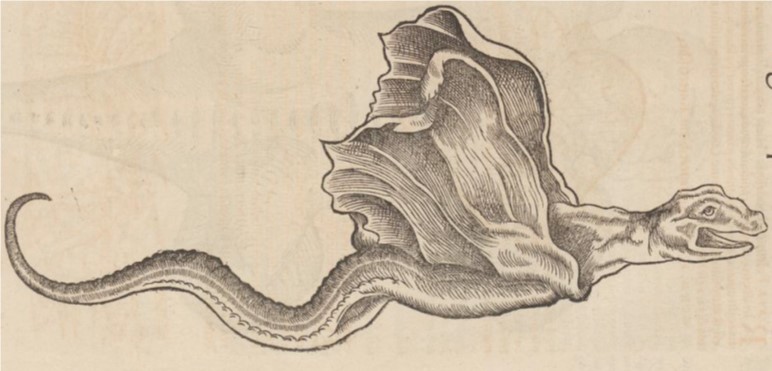
Conrad Gesner. Historiae animalium liber IIII. Zurich, Christoph Froschauer, 1558. SUB Göttingen HSD
Gessner admits that he also initially did not know the animal was a fake. The depiction was sent to him by an apothecary, who did not disclose this. Eventually however, he figured it out, and he strongly disapproved of the practice. He explains that he discloses how these creatures are made in order to warn his readers about these fakes, and about the fraudulent people who exhibit them and charge others money to see them. This needs to be explained, he writes, as “ordinary people are very much impressed with these things”.
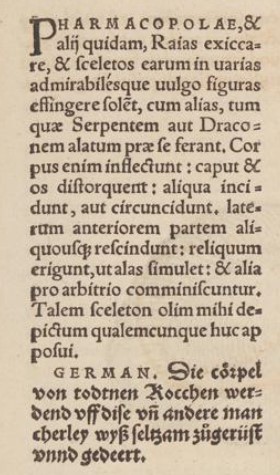
Part of Gessner’s description of the dried ray. SUB Göttingen HSD
Rays and skates are in fact extremely suitable to make creations such as these. These fish already have a suggestive appearance, their underside looks to us as if we see a semi-human face, the nostrils looking like a pair of eyes. In addition, they can be easily manipulated, by curling the side fins over the back, twisting the tail into strange positions, and using string tied behind the head to create a neck. Finally, rays and skates can be easily dried in the sun, and shrink when this is done, resulting in an even more twisted and monstrous appearance.
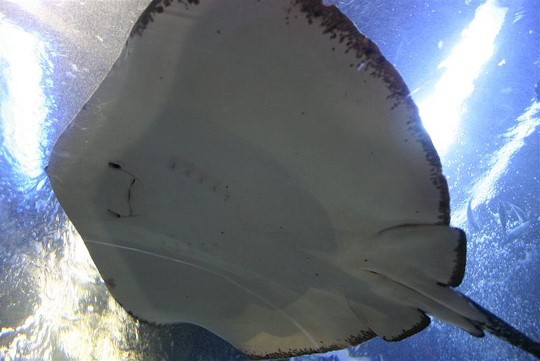
Image by Adamantiaf. (http://creativecommons.org/licenses/by-sa/2.0)%5D, via Wikimedia Commons
In 1613 Gessner’s acquaintance and correspondent Ulysse Aldrovandi published a range of depictions of such monstrous dried rays, or jenny hanivers as they are nowadays called, in his De piscibus. The origin of the term jenny haniver may lie in the French phrase jeune d’Anvers, Antwerp having been a centre of production for these things.
An ardent collector of all sorts of naturalia Aldrovandi may well have seen and handled all the jenny hanivers he included in his book. It is known he owned several of them. The here shown depictions shows one which resembles a flying dragon which looks like it is mid-flight. Much like Gessner, Aldrovandi clearly indicates that such creatures are not real.
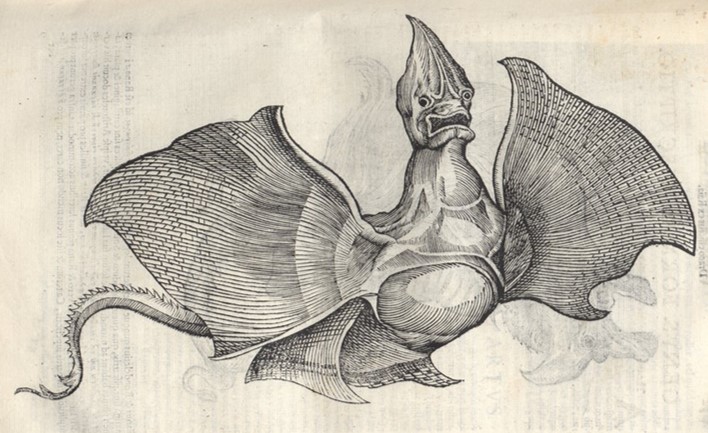
Ulysse Aldrovandi. De piscibus. Bologna, Baptiste Bellagamba, 1613. Université Louis Pasteur from University of Strasbourg.
So does this mean that once the word was out naturalists were more sceptical about reports they received about strange creatures from the sea? Perhaps that is an overstatement. In spite of his critical description of the above shown specimen, Gessner also shows Belon’s jenny haniver in his Historiae Animalium and copies Belon’s description of it almost word for word, without any of the criticism voiced in his description of the other jenny haniver. One possible explanation for this is that it mattered to Gessner whether or not information came from what he perceived as a reliable source. An esteemed naturalist such as Pierre Belon was certainly that.

Conrad Gesner. Historiae animalium liber IIII. Zurich, Christoph Froschauer, 1558. SUB Göttingen HSD
On top of this, just because something seems unlikely does not necessarily mean it isn’t true. As Gessner writes referring to other monstrous creatures, such as the sea-monk and the sea-satyr: some creatures have been reported either so often or by such reliable sources that he cannot exclude the possibility that they exist.
Further reading:
Pierre Belon. De aquatilibus. Paris, Charles Estienne, 1553.
Conrad Gesner. Historiae animalium liber IIII. Zurich, Christoph Froschauer, 1558.
Ulysse Aldrovandi. De piscibus. Bologna, Baptiste Bellagamba, 1613.
Sophia Hendrikx. Het eerste en misschien ook wel het kleinste en mooiste boek over waterdieren. In: Hans Mulder en Erik Zevenhuizen (Red.), De natuur op papier. 175 jaar Artis Bibliotheek. Amsterdam, Athenaeum-Polak & Van Gennep, 2013.
Peter Dance. Animal frauds and fakes. Maidenhead, Berkshire, Sampson Low, 1976.
© Sophia Hendrikx and Fishtories, 2016. Unauthorised use and/or duplication of this material without express and written permission from this site’s author and/or owner is strictly prohibited. Excerpts and links may be used, provided that full and clear credit is given to Sophia Hendrikx and Fishtories with appropriate and specific direction to the original content.
This blogpost also appeared on The Leiden Arts and Society Blog.
Eat What You Are: 16th century medical advice
The poem rea ds:
ds:
All sorts of fish, big and small, young and old,
Are all moist and in addition also cold,
River trout and bullheads are best to eat,
In January when the farmers thresh their wheat.
Image: Bayerische StaatsBibliothek
This is a page from a 1557 book on fishes from Lake Constance by fish fanatic Gregor Mangolt. A former priest turned protestant, Mangolt had to flee his native Germany and ended up in Switzerland, where he met and befriended the scholar Conrad Gessner, who like Mangolt happened to be fascinated with fish. This turned out to be fruitful encounter.
A few years earlier Gessner had published a calendar together with the local physician and all round celebrated literary, political and medical writer Jakob Ruf. Gessner supplied the images while Ruf supplied the text. Each month of the year was illustrated with a depiction of two local fishes and a short poem. The poems dispense advice on eating fish, reasoning from a medical perspective.
At the time the dominant medical theory was humouralism. This states that people’s personalities and their physical condition depend on the presence of four different fluids in their body: yellow bile, black bile, blood, and phlegm. If one of these is present in excess, body and mind are out of balance. The balance can be restored (or disturbed even more!) by the consumption of certain foods.
Since fish live in water they are, as the poem states, cold and wet. These are qualities that increase the amount of phlegm in the body. The eating of fish was consequently tricky business.
An excess of phlegm made a person phlegmatic, a condition that was best avoided. On the other hand, if a person had an excess of certain other fluids but a lack of phlegm, eating fish could restore balance. It could change aggressive personalities and people who tended to drink and eat to excess into more moderate people. In order to decide what you should eat, you should therefore first consider who you were. In order to make sure the right people ate fish, and others did not, the calendar provides playful instructions through the included poems.
When Gessner read Mangolt’s book of fish, which provides descriptions of a range of local species, he felt this would go well with his fish calendar. Mangolt did not provide illustrations and his text is rather dry, the addition of Gessner’s calendar certainly made it more lively. On the other hand, Gessner’s calendar provided little serious information and Mangolt’s text could provide a welcome balance.
There was only one problem, Mangolt did not want his fish book published.
This however did not deter Gessner. He asked to borrow the manuscript and took it to his cousin, Andreas Gessner, who was a printer. The Gessner cousins then proceeded to mix the calendar and Mangolt’s text to create a joint publication. The above image is one of the first pages of the end result. When the book was printed the Gessners listed Mangolt as the sole author on the title page.
We can only guess how Mangolt felt about this. However we do know that the book was reprinted at least twice, it appears therefore that he put his reservations about publishing his work aside.
That being said, the calendar was removed from the later two editions…
Further reading:
- Keller, Hildegard Elisabeth: Edition, Einleitung und Kommentar der Fischsprüche. In: Keller, Hildegard Elisabeth (Hg.): Jakob Ruf. Leben, Werk und Studien, Zürich 2008 (Jakob Ruf, Leben, Werk Studien Vierter Band), S. 967-993.
Also see: Conrad Gessner Historiae Piscium – Rare Fish Books
Sophia Hendrikx and Fishtories, 2016. Unauthorised use and/or duplication of this material without express and written permission from this site’s author and owner is strictly prohibited. Excerpts and links may be used, provided that full and clear credit is given to the author and Fishtories with appropriate and specific direction to the original content
Culinary fish-poetry: Francois Boussuet, De Natura Aquatilium Carmen, 1558.
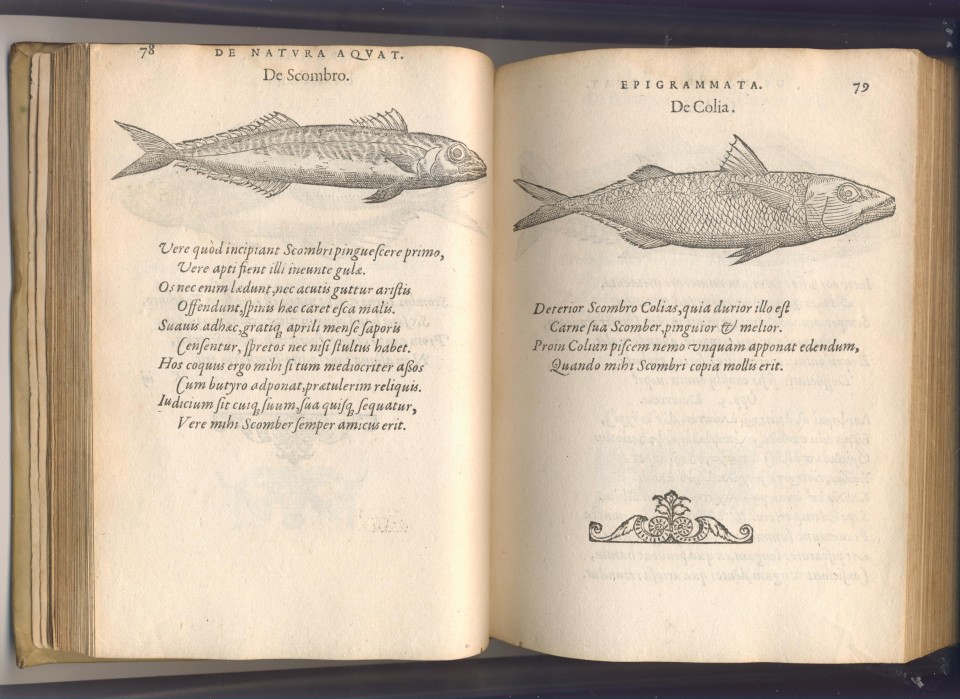
The left hand page reads:
On mackerel:
As mackerels begin to grow fat in the early spring,
When the spring comes, they will be suitable for the gullet.
Because they do not hurt the mouth, nor hit throat with sharp bones,
This dish is free from harmful bones.
And they are praised for their sweet and pleasant taste in the month of April,
Only a fool rejects them.
So if the cook serves them to me around that time, moderately roasted with butter,
I will prefer them to all others.
To everyone his own judgement, and may everyone decide for himself,
But mackerel will always be a friend to me.
In his 1558 De natura aquatilium carmen Bousuet reproduced all the excellent woodcuts from Guillaume Rondelet’s Libri de Piscibus Marinis, including the sea monk and the sea bishop. Rather than Rondelet’s descriptions of the various species, elegant poems on the culinary, and in some cases medicinal, value of fish were added to the depictions.
More information available from Rare Fish Books: Rare Fish Books – Francois Boussuet, De Natura Aquatilium Carmen
Sophia Hendrikx and Fishtories, 2016. Unauthorised use and/or duplication of this material without express and written permission from this site’s author and owner is strictly prohibited. Excerpts and links may be used, provided that full and clear credit is given to the author and Fishtories with appropriate and specific direction to the original content
Parrot fish as a symbol of friendship: Joachim Camerarius the Younger’s Symbolorum et Emblematum (1604)

The above image is taken from the fourth volume of Joachim Camerarius the Younger’s emblem book Symbolorum et Emblematum, published in 1604. The story behind the depicted scene goes back to Pliny’s Natural History, which states that parrot fishes help their friends escape from wicker-basket traps by pulling them out by their tails. As a result, parrot fish came to be known as a symbol of friendship. In fact, this is a gross misinterpretation. In regions where wicker-basket traps are still used to catch these fish, the species is known for violently attacking specimens of their kind who have gotten stuck between the twigs of the traps.
Digital version available at: Bayerische StaatsBibliothek
This post is based on a conference paper I presented at the Emblems and the Natural World conference, Münster (Germany), December 17-18, 2015.
Sophia Hendrikx and Fishtories, 2016. Unauthorised use and/or duplication of this material without express and written permission from this site’s author and owner is strictly prohibited. Excerpts and links may be used, provided that full and clear credit is given to the author and Fishtories with appropriate and specific direction to the original content

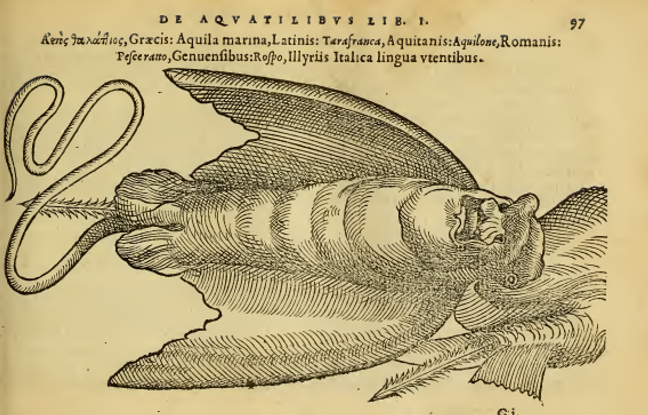
















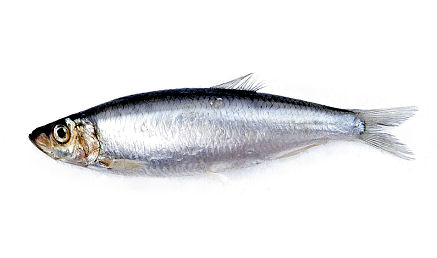 Sprat?
Sprat?